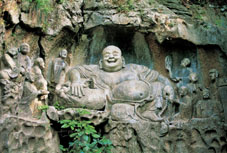 With rolling wooded hills on three sides, the West Lake in Hangzhou, the capital city of Zhejiang Province, covers an area of 5.66 square kilometers. Around the lake, there are many scenic spots, including Xiaoyingzhou (Lesser Yingzhou, an islet) and Santan Yingyue (Three Pools Reflecting the Moon, a part of Lesser Yingzhou). In the surrounding hills, there are many temples, pagodas, natural springs, caves, and rock carvings. Among the temples, the Lingyin Temple is the largest and most resplendent; and it attracts a great number of tourists from home and abroad.
With rolling wooded hills on three sides, the West Lake in Hangzhou, the capital city of Zhejiang Province, covers an area of 5.66 square kilometers. Around the lake, there are many scenic spots, including Xiaoyingzhou (Lesser Yingzhou, an islet) and Santan Yingyue (Three Pools Reflecting the Moon, a part of Lesser Yingzhou). In the surrounding hills, there are many temples, pagodas, natural springs, caves, and rock carvings. Among the temples, the Lingyin Temple is the largest and most resplendent; and it attracts a great number of tourists from home and abroad.
The Lingyin Temple, west of the lake, stands at the foot of the Beigao Peak and faces the Feilai (Peak That Flew Here) Peak across a stream. With many old trees, groves of bamboo, and quiet and beautiful surroundings, the Lingyin Temple is one of the most famous temples south of the Changjiang (Yangtze) River.
There is a story about the Feilai Peak and the temple. The story is about Huili, a Buddhist monk from India who visited Wulin Hill (present Feilai Peak) in 326, the first year of the reign of Emperor Xian He of the Eastern Jin Dynasty (317-420). Huili insisted that the hill looked exactly like the Grdhrakuta in India and asked when the peak had flown to Hangzhou. To fortify his claim, he said that the Grdhrakuta had a white monkey and a black monkey in one of its caves. When the two monkeys were indeed found in a cave in the hill, it was recognized as the Feilai Peak (Peak That Flew Here). Later, the houses built there by Huili were called the Lingyin (Soul's Retreat) Temple.
Over the past 1,600 years, the temple has been both ruined and rebuilt many times. It experienced its zenith during the Five Dynasties Period (907-960). The temple had 9 buildings, 18 towers, and 72 halls with 1,300 rooms and more than 3,000 monks.
Today, the Lingyin Temple is made up of the Hall of the Heavenly King, the Hall of the Great Hero, the Hall of the Buddha of Medicine, the East and West Winding Corridors, the west wing, the Liandeng Tower, the Dabei Tower, the Abbot's Room, and the dining halls. The 33.6-meter-high Hall of the Great Hero is the temple's most magnificent building.
In July 1949, not long after the liberation of Hangzhou, the Hall of Great Hero collapsed and three statues of the Buddha were damaged. The collapse was due to the disintegration, caused by termites, of a 28-meter-long principal ridge purline. The government of Hangzhou was unable to rebuild the temple at that time, so the temple was temporarily closed.
In the summer of 1951, when Premier Zhou Enlai visited Hangzhou, leaders of the municipal government of Hangzhou and the provincial government of Zhejiang told the Premier about the Lingyin Temple, the state it was in, and their ideas of rebuilding it. The Premier said that, as one of China's ancient temples, the Lingyin Temple had a tremendous influence on Buddhist communities inside and outside China and should be protected by the government at all levels.
Soon after the Premier's visit, the State Council ratified a plan to renovate the temple and appropriated 1.2 million yuan and building materials, including timber, steel, cement, and gold, for the renovation. Two years later, the Hall of the Great Hero, the main hall of the temple, was rebuilt.
In the center of the Hall of the Great Hero, there is a magnificent statue of Sakyamuni that is 9.1 meters tall and is seated on a 10.5-meter-high pedestal. Carved out of 24 pieces of fragrant camphor wood and gilded in gold, the statue attracts groups of worshipers everyday.
On the Feilai Peak, there are many rock carvings of Buddhas, Bodhisattvas and Arhats, as well as carvings depicting Xuan Zang's trip to India to acquire Buddhist scriptures, from the Five Dynasties Period to the Yuan Dynasty (1271-1368). Among the carvings, the vivid image of Maitreya, the fat bare-bellied Buddha with a smiling face, has become the symbol of the Lingyin Temple.
The Lingyin Temple has received numerous tourists from all over the world. During the Spring Festival (Chinese New Year) celebrations, about 70,000 people per day come to the temple to worship.
Transportation: Bus 7, 807 and Tour Bus 1, 2, 4 arrive at Linyin Station.
Entrance Ticket: 30 yuan (US$1=8.3 yuan)
(China Pictorial December 12, 2002)
|

